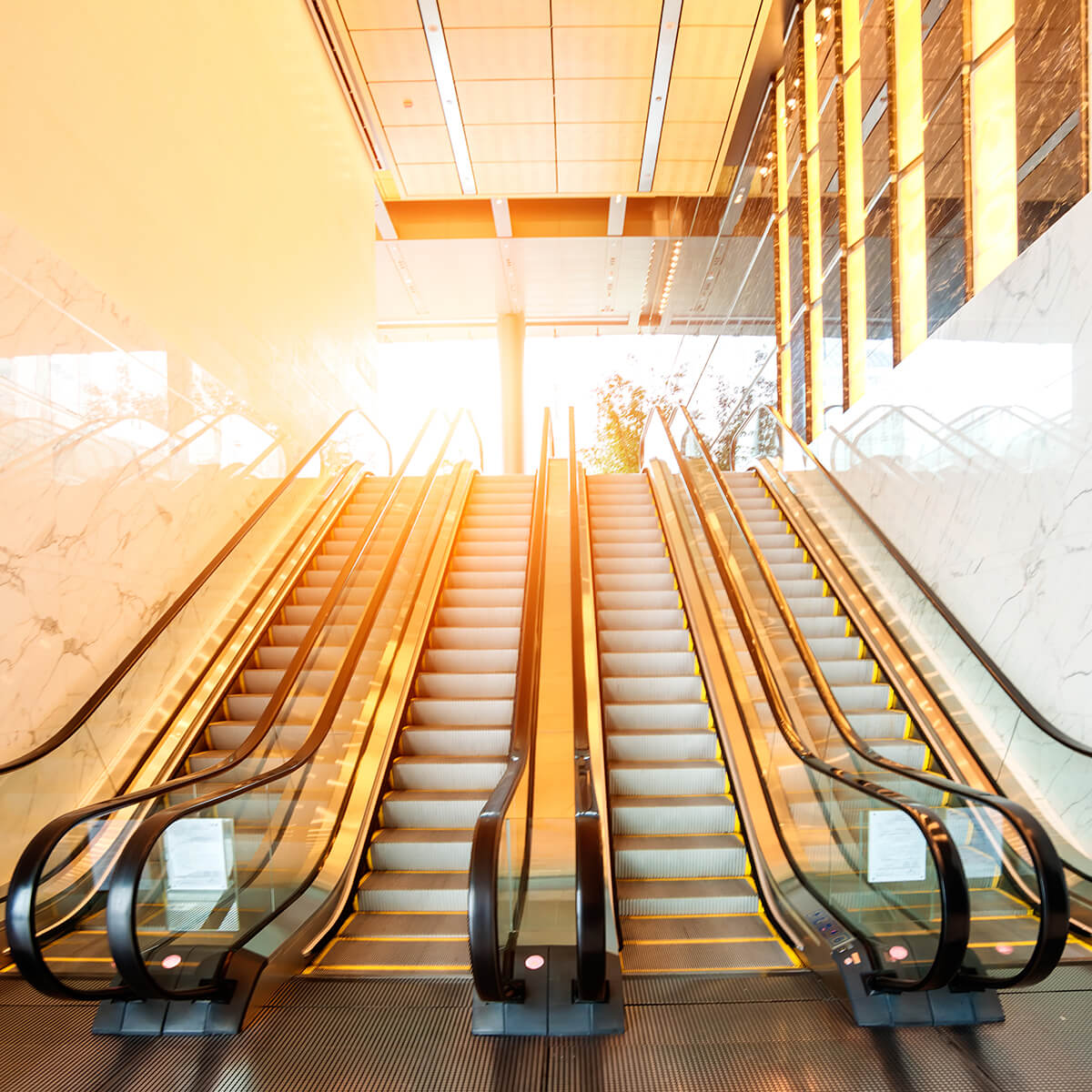Most of us have probably used an escalator and moving walkway without even thinking about how these fixtures make our lives easier. The two might sound similar, but escalators and moving walkways are distinct from each other. We look at their key differences and how these differences impact their application in different sites.
Escalator and Moving Walkways Definition
Put simply, an escalator is a moving staircase that transports people vertically while a moving walkway is a moving walkway transporting people horizontally.
Escalator
Escalators are shaped like stairs, and they’re designed to move people up and down different levels. Passengers on escalators can choose to stand or walk on escalators, and moving balustrades are part of the escalator system. Escalators are often found in pairs, with one heading downwards and one transporting people upwards. Inclination angles are typically between 30 and 35 degrees.
Moving Walkway
While escalators move people between floors or heights in a vertical fashion, moving walkways are like slow conveyor belts that transport people across horizontal distances. Sometimes, like escalators, they move people on an incline and between different floors. They’re often installed in airports, and like escalators, passengers can stand or walk on them using balustrades for support.
Again, like escalators, moving walkways are sometimes found in pairs, transporting people in opposite directions. Inclination angles are much narrower or smaller than escalators; moving walkways might come in angles of 0 to 6 degrees.
Escalator vs Moving Walkways: Important Differences
Both escalators and moving walkways support optimal traffic flow in commercial and other property types, though they might do so slightly differently. Both types to be fairly energy intensive but energy-efficient technologies are available.
Traffic Flow
Escalators allow businesses to connect different floors and direct high volumes of traffic through certain areas in a particular order. Inclined moving walkways can help sites achieve the same type of multi-floor connection. Horizontal moving walkways connect horizontally related spaces, allowing crowds to travel quickly across necessarily large spaces like airports and train stations more effectively.
Both types support rapid, self-assisted movement across spaces. They could support higher customer density and mobility, and in turn, potentially higher sales and profitability. So the direction of flow is the key point of difference between the two when it comes to traffic flow – horizontal or vertical.
Energy Efficiency
For moving walkways and escalators, energy consumption is largely dependent on total running time and passenger load. Energy-saving measures like LED lighting and high-efficiency motors can have a significant impact on energy conservation. In addition, using a smaller motor to match loads (rather than assuming maximum load) can help save energy for both types.
Sites can also use motor-efficiency controllers (MECs), which boost efficiency during part-load periods. MECs support regenerative braking, which in effect turns the motor into a generator when passengers are transported downwards. This energy can be used for lighting and other applications in the building.
Different modes – for both escalators and moving walkways – could also enhance energy efficiency. Intermittent drives with sensor systems enable these different modes. For example, your site could use a continuous operation mode, which would be the least energy-efficient setting. A stop-and-go mode can offer an on-demand transport that powers down to standby when no one is on the escalator or moving walkway.
Alternatively, you could have a continuous operation with a crawling mode that automatically switches on when no one is riding the escalator or moving walkway. At the same time, the crawling mode would switch off when a passenger approaches.
Types of Properties
Depending on the property, escalators or moving walkways might be more suitable for your purposes.
- Airports – The flat, stair-less design of the moving walkway makes it popular for sites like airports because it’s easier to move a luggage cart across a flat surface. A similar type of site could be major train stations.
- Shopping centres – Shopping centres might have little use for flat moving walkways, but escalators and inclined moving walks supporting shopping trolleys can be essential additions these sites.
- Hotels – Denser spaces like hotels might not use moving walkways but have escalators to support guests moving around. Other similar spaces could be movie theatres, libraries, and museums.
- Office buildings – Space-conscious office buildings, like hotels, might have escalators as well as lifts.
- Trade centres – Large sites like trade centres need to accommodate large volumes of people, high traffic flows, and things like marquees, booths, and specialised equipment. Visitors might need to cover large distances, so inclined moving walks, flat moving walkways, and escalators could all be useful additions.
Escalators and moving walkways can be invaluable additions to commercial and other types of properties as they facilitate traffic flows so effectively. The two types differ in the sense escalators usually convey people vertically while moving walkways can convey people vertically and horizontally. This and the walkway-versus-stair design means certain types of properties are better off with either while some can benefit from having both.
Liftronic has more than 30 years of experience in lift design, installation and maintenance. If you’re looking for an elevator, escalator, or moving-walkway solution for your property, contact us for a discussion today.

